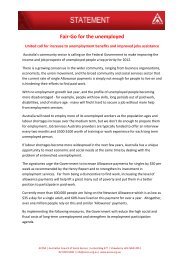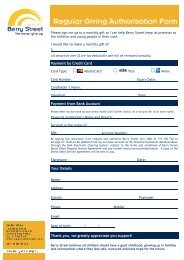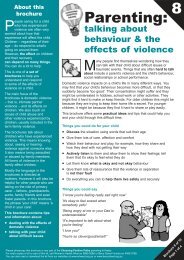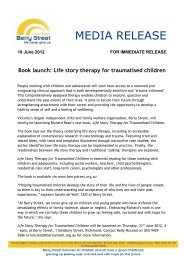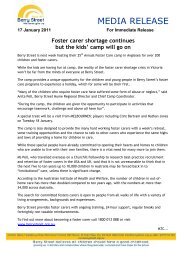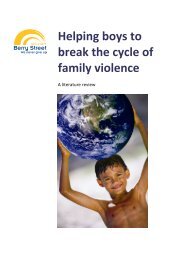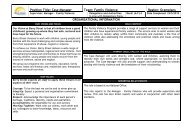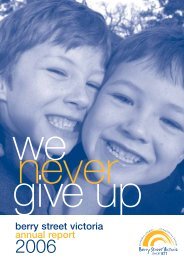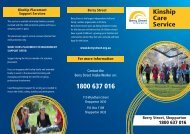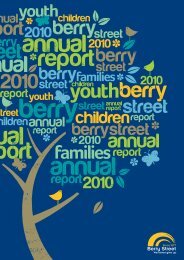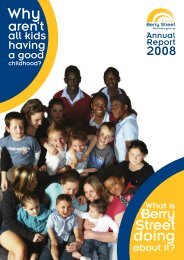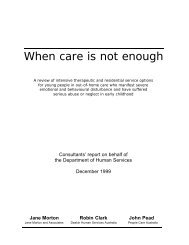Take Two - Third Evaluation Report More than Words ... - Berry Street
Take Two - Third Evaluation Report More than Words ... - Berry Street
Take Two - Third Evaluation Report More than Words ... - Berry Street
You also want an ePaper? Increase the reach of your titles
YUMPU automatically turns print PDFs into web optimized ePapers that Google loves.
changes directly for the children, such as to enhance<br />
their emotional, behavioural, social, cultural, and/or<br />
physical wellbeing; reduce emotional and behavioural<br />
symptoms; and to support recovery from trauma. Other<br />
desired outcomes included to strengthen parents, carers<br />
and others’ capacity to meet the children’s emotional,<br />
developmental and other needs.<br />
Although more research is required to understand ‘what<br />
works’, this report provides an in-depth description of<br />
<strong>Take</strong> <strong>Two</strong>’s therapeutic activities. The highest proportion<br />
of time spent on therapeutic activity by <strong>Take</strong> <strong>Two</strong> was<br />
in individual work with children, followed by work with<br />
parents and carers about the children. There is also a<br />
high degree of activity spent in working therapeutically<br />
with the service system. The report also outlines <strong>Take</strong><br />
<strong>Two</strong>’s consultation role regarding children who are not<br />
clients. This is an important role well recognised as<br />
valuable, however, further analysis is required.<br />
4. Outcomes for children<br />
This evaluation report has been able to expand on the<br />
previous report in documenting evidence of positive<br />
outcomes for <strong>Take</strong> <strong>Two</strong> clients. The second evaluation<br />
report identi ed positive trends in client outcomes<br />
and this report presents statistically signi cant<br />
positive outcomes. This is notable given the program<br />
commenced in 2004 and had to create, consult, train<br />
and implement an outcomes framework at the same<br />
time as the program itself was being created.<br />
The outcomes framework developed by <strong>Take</strong> <strong>Two</strong><br />
includes four outcome measures. These are the<br />
Strengths and Dif culties Questionnaire (SDQ;<br />
Goodman, 1997), the Trauma Symptom Checklist for<br />
Children (TSCC; Briere, 1996), the Trauma Symptom<br />
Checklist for Young Children (TSCYC; Briere, 2005)<br />
and Social Network Maps (Tracy & Whittaker, 1990).<br />
In addition to measuring outcomes, these measures<br />
have also been valuable to describe different aspects of<br />
the children’s situation at baseline. The fourth type of<br />
measure used in this evaluation is the stakeholder and<br />
clinicians’ feedback through use of surveys.<br />
4.1 Emotional and behavioural symptoms<br />
Emotional and behavioural symptoms — baseline<br />
data<br />
Over 500 SDQs were completed providing baseline data<br />
and are reported in Chapter 7. Findings at baseline<br />
supported the conclusion that many of the children<br />
presented in the borderline or clinical range in various<br />
areas of dif culties. Carers (67%), followed by parents<br />
(60%), teachers (53%) and then the young people<br />
themselves (46%) reported three or more out of ve<br />
scales in the clinical range. Similarly, the total dif culties<br />
score was reported in the borderline or clinical range<br />
for the large majority of children according to all types<br />
of respondents. The analysis showed that the majority<br />
of children had experienced problems for over a year.<br />
<strong>More</strong>over, all groups of respondents noted that the<br />
dif culties impacted upon the daily lives of the children<br />
and others, such as family, friends and school. Further<br />
study as the sample size grows will include triangulation<br />
of the data across different types of respondents for<br />
each child.<br />
xxiv<br />
The analysis compared results from the HCA analysis<br />
with the SDQ data. The ndings though preliminary<br />
indicate different associations between abuse and<br />
neglect and perception of dif culties by the young<br />
people, parents, carers and teachers. This was the rst<br />
time this type of analysis was attempted and only the<br />
total dif culties scores in the SDQs were analysed. The<br />
ndings require more detailed exploration over time as<br />
the sample grows of those for whom there is an SDQ.<br />
Emotional and behavioural symptoms —<br />
outcomes data<br />
SDQs repeated over two time periods were completed<br />
by 58 children, 20 parents, 70 carers and 66 teachers.<br />
There were reductions between those reported in the<br />
clinical range from the rst to the last SDQs in each scale<br />
and total dif culties scores according to all respondent<br />
types. These reductions were most commonly<br />
signi cant in the SDQs completed by the young people.<br />
For example, there was a signi cant number of young<br />
people who were no longer in the clinical range in<br />
terms of conduct problems, hyperactivity, prosocial<br />
behaviours and total dif culties scores. The other<br />
signi cant reduction was reported in the parents’ SDQs<br />
regarding fewer children’s total dif culties scores being<br />
in the clinical range.<br />
Analysis of reductions in the mean scores over time<br />
found a reduction according to the young person’s SDQs<br />
on all the scales with signi cant reductions in concerns<br />
regarding conduct, hyperactive and psychosocial<br />
scales. There were signi cant reductions in the mean<br />
scores according to the parents’ SDQs in the areas<br />
of the children’s conduct problems, hyperactivity<br />
and total dif culties scores. Analysis of carers’ SDQs<br />
found a signi cant reduction in the mean score of peer<br />
problems over time. Teachers reported the least change<br />
over time, but were also the only ones included in the<br />
analysis where the SDQs were not always completed by<br />
the same teacher over the different time periods.<br />
A question in the follow-up version of the SDQ asked<br />
respondents whether or not the service was helpful.<br />
The majority of all respondent types reported that <strong>Take</strong><br />
<strong>Two</strong> made the children’s problems better and that the<br />
service was helpful in other ways.<br />
4.2 Trauma symptoms<br />
Trauma-related baseline data<br />
As reported in Chapter 8, the valid TSCCs were<br />
completed at baseline for 105 children. The baseline<br />
data show that many <strong>Take</strong> <strong>Two</strong> clients scored highly in<br />
the clinical range of trauma-related symptoms. Fortysix<br />
percent of the TSCCs had at least one scale and 28<br />
percent had more <strong>than</strong> one scale in the clinical range.<br />
There were 90 TSCYCs completed by parents or carers<br />
at baseline. Over two-thirds of the children had at least<br />
one scale and just over half had two or more scales<br />
in the clinical range. Signi cant differences were found<br />
for older children and females who were more likely to<br />
have two or more scales in the clinical range.<br />
Both the TSCC and TSCYC data was compared with HCA<br />
data in terms of experience of abuse and neglect and<br />
presentation of dif culties according to the referrers.<br />
Clearer patterns emerged in this data compared to<br />
the analysis regarding SDQs and HCA data, however<br />
it is still preliminary and further exploration is required<br />
Frederico, Jackson, & Black (2010) “<strong>More</strong> <strong>than</strong> <strong>Words</strong>” – <strong>Take</strong> <strong>Two</strong> <strong>Third</strong> <strong>Evaluation</strong> <strong>Report</strong>, La Trobe University, Bundoora, Australia



